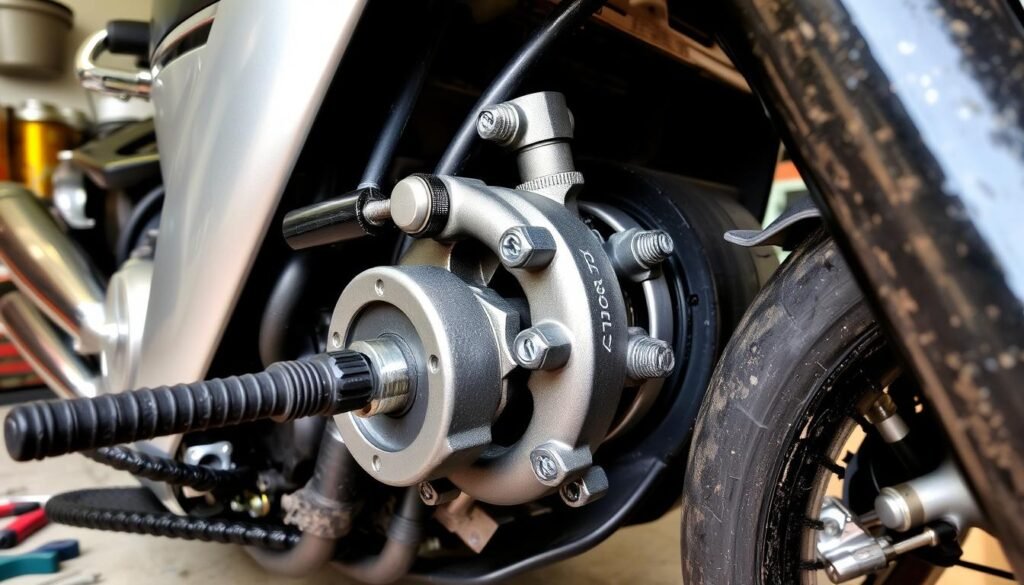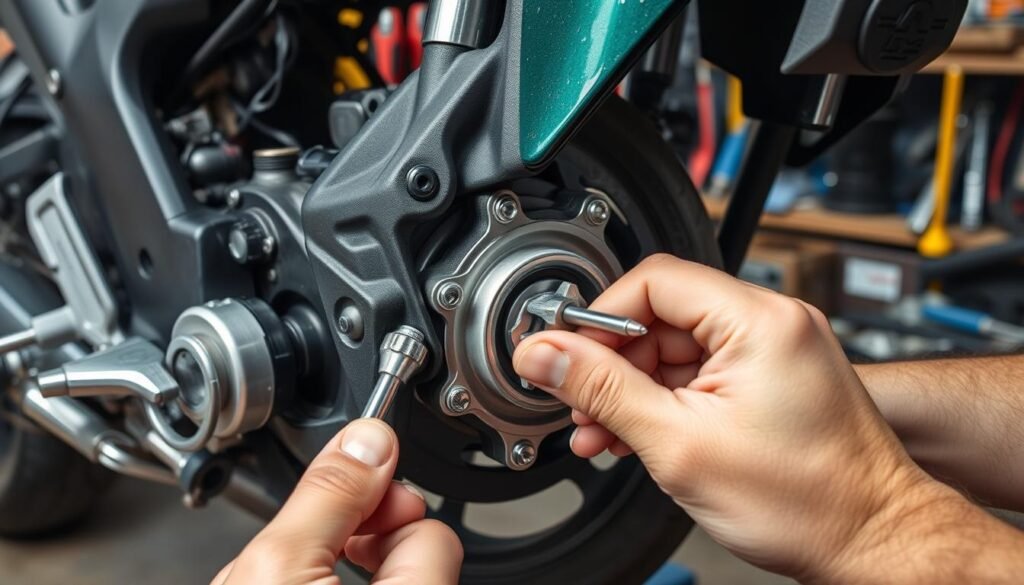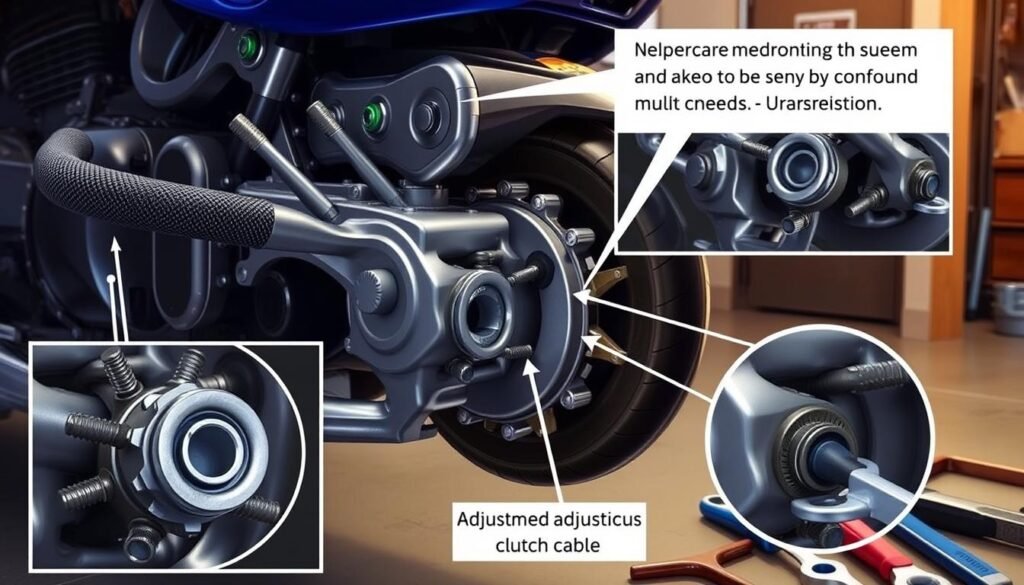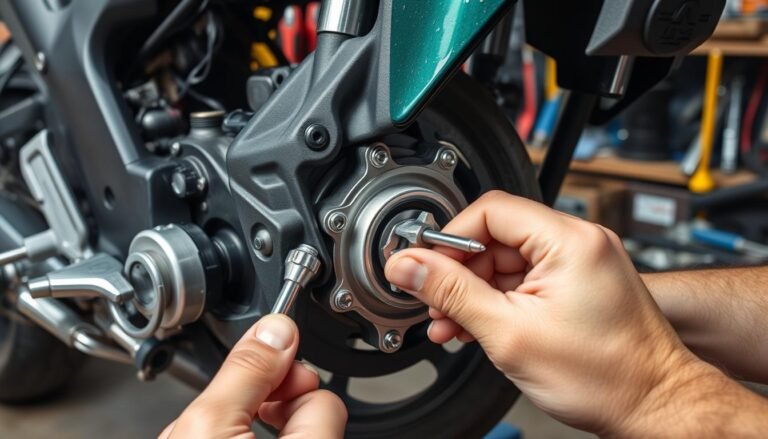Did you know nearly 30% of motorcycle riders face clutch adjustment issues? This shows how vital it is to know how to adjust the Victory clutch. It ensures smooth gear changes and better bike handling.
Clutch maintenance is key for Victory motorcycle riders. It greatly affects your riding experience and bike management.
This guide will give you important tips on Victory motorcycle clutch service. You’ll learn how to adjust the clutch right. With a few easy steps, you can make your ride better and extend your clutch’s life. Let’s explore how to improve your Victory motorcycle experience.

Key Takeaways
- Effective clutch adjustment improves ride quality and handling.
- Regular maintenance helps prevent common clutch issues.
- Understanding clutch mechanisms is essential for effective service.
- Simple tools can assist in performing clutch adjustments at home.
- Testing your clutch after adjustments ensures optimal performance.
- Upgrading your clutch system can offer significant benefits.
What is a Clutch Adjustment?
Clutch adjustment is about fine-tuning your motorcycle’s clutch system. It ensures the clutch lever engages and disengages smoothly. Proper Victory clutch adjustment is key to your bike’s performance. It affects how well the bike responds to the throttle and shifts gears.
If you don’t adjust the clutch correctly, you might face bigger problems. These issues can impact your riding experience.
Importance of Clutch Adjustment
Keeping the clutch settings right is very important:
- It makes the bike accelerate smoothly.
- It helps shift gears better, avoiding missed shifts.
- It also makes the clutch last longer, saving you money on repairs.
Without regular Victory clutch maintenance, you might run into problems. For example, the 2016 Victory Magnum had clutch failures at around 26,000 miles. If the clutch isn’t adjusted right, it can slip, affecting the bike’s power and performance.
Signs You Need an Adjustment
Knowing when your bike needs a clutch adjustment is key to avoiding bigger issues. Watch for:
- Too much play in the clutch lever, causing disengagement problems.
- Hard time shifting gears, often due to bad cable adjustment.
- A hard pull on the lever, meaning not enough free play and risking slipping.
Don’t ignore your bike’s clutch system. Paying attention to these signs is crucial for keeping your bike running well.
Tools Required for Clutch Adjustment
Having the right tools is key for effective Victory clutch maintenance. The right equipment makes the adjustment easier and safer. Here’s what you need for a successful clutch adjustment.
Basic Tools Needed
Start with these basic tools for clutch adjustment:
- Wrenches (various sizes)
- Screwdrivers (flathead and Phillips)
- Cable lubing tool
- Torque wrench for precise measurements
- Scissors or wire cutters for any cable adjustments
Safety Equipment
Keeping safe while working on your motorcycle is crucial. Use these safety items during adjustment:
- Protective gloves to shield hands from sharp tools and debris
- Safety goggles to prevent dust and small objects from injuring the eyes
- Mechanics’ apron to keep clothing clean and protected
Proper tools and safety gear improve Victory clutch maintenance. Before you start, make sure you have all the tools and safety items. This will make the process smoother and safer.
Understanding Victory Motorcycles’ Clutch System
The clutch system in Victory motorcycles is key to the bike’s performance. Each part works together for a smooth ride. Regular checks by a skilled mechanic keep everything running smoothly.
Overview of the Clutch Mechanism
The clutch has four to six sets of springs that help the lever work. These springs make sure the clutch plates engage and disengage smoothly. To keep the clutch in top shape, you need to check:
- Clutch cable for wear and tear
- Actuator arm for bending or corrosion
- Transmission oil levels
- Clutch lever pivot points for cleanliness
Common Issues with Clutch Systems
Riders may face Victory clutch issues as the bike ages. Some common problems include:
- A hard-to-pull clutch lever due to a corroded or bent actuator arm
- Dirty or worn clutch cables cause more friction
- Clutch plates that don’t respond well and need to be replaced
- Difficulty in using the clutch, often because of dirty pivot points
- Low transmission oil causes mechanical problems
Fixing these issues quickly with a detailed Victory motorcycle clutch service can improve your ride. Knowing about these common problems helps riders keep their bikes in good shape.
Step-by-Step Guide to Clutch Adjustment
Learning how to adjust your Victory bike’s clutch is key for top performance. A well-adjusted clutch makes riding smoother and more fun. Here’s how to tune your Victory clutch right.
Preparing Your Bike
First, park your bike in a flat, stable spot with the engine turned off. This step is vital for making accurate adjustments safely. It helps you focus on the task without any interruptions.
Locating the Clutch Adjustment Mechanism
The clutch adjustment for Victory bikes is usually on the right side. You might need to take off the side cover to get to it. Be careful not to scratch anything while you work.
The Adjustment Process
Start by loosening the lock nut. Then, adjust the barrel adjuster to change the lever’s feel. Make small tweaks, as even a little change can help a lot. A small adjustment of about 1/16″ might be needed for the clutch cable.
When you’ve found the right setting, tighten the lock nut well. Check the lever’s free play, aiming for about 1/16″. Regular adjustments can improve your bike’s handling.

| Adjustment Parameter | Recommended Measurement |
|---|---|
| Free Play at Lever | 1/16″ |
| Closed Adjuster Length | 4 1/4″ |
| The outside Diameter of the Adjuster | .372″ (max .375″) |
| Internal Diameter of Conduit | 5/16″ |
Adjusting the Clutch at the Lever
Adjusting the clutch at the lever is key for a smooth ride. Over time, the clutch’s feel might change, needing an adjustment for better performance. A well-adjusted clutch makes gear changes smooth and improves your ride.
Importance of Lever Adjustment
Lever adjustment is vital for the clutch’s function. If the lever is too far from the handle, it can cause problems. This can make shifting gears and accelerating harder.
The manual says to keep the clutch free-play between 0.5mm to 1.5mm. Getting this just right helps with control, especially at high speeds or on slippery surfaces.
How to Adjust the Lever
To start, loosen the locknut on the lever. Then, adjust the barrel to set the lever’s distance from the grip. You want a bit of play so the clutch fully disengages.
Adjusting a few times can help get it just right. This keeps the clutch working well and avoids costly Victory clutch repair later on.
| Adjustment Step | Description |
|---|---|
| 1. Loosen the Locknut | Use a wrench to carefully loosen the locknut on the clutch lever. |
| 2. Adjust Barrel | Turn the barrel adjuster to increase or decrease the lever distance. |
| 3. Tighten Locknut | Once adjusted, securely tighten the locknut back into place. |
| 4. Test the Clutch | Pull the lever to check for proper engagement and free-play. |
Adjusting the Clutch at the Cable
Getting the cable right is key for a smooth clutch system. Issues like worn-out cables or wrong adjustments can cause problems. Regular maintenance helps avoid these issues and keeps your bike running well.
Identifying Cable Issues
Spotting cable problems is important for your Victory’s health. Watch out for these signs:
- Fraying: Look for any wear or damage on the cables.
- Binding: Make sure the cable moves smoothly without any blockages.
- Incorrect Free-play: Too little free-play can make shifting hard, especially when the bike warms up.
Ignoring these signs can lead to early clutch failures. Cable, master cylinder, or lever issues are often the cause.
Cable Adjustment Procedure
To adjust the cable correctly, follow these steps:
- Loosen the adjustment nuts where the cable meets the clutch lever.
- Adjust the cable for smooth clutch engagement.
- Tighten the nuts well once you’ve got the right adjustment.
Regular checks and lubrication keep the cable in good shape. These steps can help prevent clutch issues and make riding more fun.
Testing Your Clutch After Adjustment
After adjusting the clutch, it’s vital to test it thoroughly. This ensures the bike rides smoothly and responds well. To check, start in neutral, shift to first gear, and slowly release the clutch while you press the throttle.
Listen for any unusual sounds or feel any odd sensations. Try a few starts to see how it handles when you accelerate. Remember, common mistakes can mess up your test results.
How to Test the Clutch Effectively
- Start by ensuring the bike is in neutral.
- Shift to first gear and gradually release the clutch while applying the throttle.
- Observe the responsiveness of the bike; it should engage smoothly without jerking.
- Check for any unusual sounds or sensations during the process.
- Perform a few starts from a stop to gauge the performance during acceleration.
Common Testing Mistakes
- Failing to fully engage the clutch can lead to misdiagnosis of problems.
- Overlooking any residual slack in the system may cause issues to go unnoticed.
- Testing in a controlled environment is crucial; busy roads can lead to distractions during evaluation.
- Neglecting to adjust for riding style variations can result in inconsistent engagement.
By following the right steps for adjusting your Victory clutch and doing thorough tests, you can make your ride better. Make testing a regular part of your Victory clutch care to stay safe and ride well.
Troubleshooting Clutch Adjustment Problems
Riders often face challenges even after adjusting their clutches. Issues like finding neutral gear hard, clutch dragging, and jammed gearboxes can occur. To fix these problems, it’s important to check the adjustments and the cable’s condition. Here are common issues and possible solutions.
Identifying Common Issues
- Difficulty Finding Neutral Gear: This problem can be more pronounced when the engine is either cold or warm. Worn-out parts may lead to this issue, often occurring alongside clutch dragging.
- Clutch Dragging: Symptoms include a sensation of resistance when the lever is pulled. This condition can stem from wear on the clutch basket and its components.
- Jammed Gearbox: This issue is independent of clutch cable adjustments, highlighting a unique mechanical failure that needs separate attention.
Solutions for Adjustment Errors
Addressing clutch issues often involves several steps:
- Re-evaluate Adjustments: Confirm the initial adjustments align with the manufacturer’s specifications.
- Inspect Mechanical Components: Regularly checking the condition of clutch plates, cables, and other related parts helps identify signs of wear.
- Check for Excessive Cable Tension: Over-tightened cables can lead to clutch dragging and difficulty finding neutral.
- Replace Worn Parts: Components such as the shift drum bolt and clutch basket should be replaced as necessary to restore function.
Following these Victory clutch adjustment tips provides a systematic approach to resolving common clutch problems. By taking care of these issues early, riders can enjoy a smoother and safer performance on their Victory motorcycles.

| Issue | Potential Causes | Recommended Solutions |
|---|---|---|
| Difficulty Finding Neutral Gear | Worn parts, improper adjustment | Re-evaluate adjustments, inspect clutch plates |
| Clutch Dragging | Worn clutch basket, excessive tension | Adjust cable tension, replace worn components |
| Jammed Gearbox | Independent mechanical failure | Consult a professional for inspection |
Maintenance Tips for Your Clutch System
Keeping your Victory motorcycle’s clutch system in top shape is crucial. Regular checks and smart riding habits can avoid expensive fixes. Here are key tips for maintaining your Victory motorcycle’s clutch.
Regular Inspection Practices
Regular checks on your clutch system can extend its life and keep it running smoothly. Here are some important practices to follow:
- Check the clutch cable and adjuster for wear and tear.
- Make sure the clutch cable is well-lubricated for smooth action.
- Pay attention to the lever’s feel; any changes could mean trouble.
- Keep an eye on oil levels, as low oil can cause serious engine problems.
- Watch how the transmission performs during rides. Clutch slippage might show up as odd gear shifts or engine revs.
When to Seek Professional Help
While you can do many maintenance tasks yourself, some need a pro’s touch. Here are times when you should get help:
- If clutch problems keep coming back after you’ve tried to fix them.
- If you’re not sure about doing repairs because you lack experience.
- For complex tasks like emission system service, which need special training and tools.
- When replacing clutch parts, especially if it’s going to cost a lot.
Being part of a maintenance program can greatly lower the chance of failures and unexpected costs. By being proactive and knowing when to get professional help, you can keep your Victory motorcycle running at its best.
Upgrading Your Clutch System
Upgrading your motorcycle’s clutch system can make a big difference. It improves handling and ride quality. Riders will notice better control and less effort needed to shift gears.
Benefits of Upgrading
A better clutch system stops slippage, making gear shifts smoother. It also means more power and better efficiency. The main advantages are:
- Improved Ride Quality: It makes riding smoother and more enjoyable.
- Increased Responsiveness: Faster throttle response means better acceleration.
- Reduction of Pull Effort: You need less effort to shift gears, making long rides easier.
Popular Upgrades for Victory Bikes
Victory bike fans often choose certain upgrades for their clutches. Here are some popular ones:
- Lightweight Clutch Springs: They offer a stiffer feel for better control.
- Aftermarket Levers: Custom levers can be more comfortable to hold.
- High-Performance Friction Plates: These improve grip and reduce slip under heavy loads.
Those looking for a full Victory motorcycle clutch service will see big improvements. Choosing the right upgrades depends on your riding style and how often you ride. This ensures the upgrades meet your needs and preferences.
Clutch Adjustment FAQs
Many riders have questions about clutch adjustments and maintenance. Knowing common concerns can help with troubleshooting. Here are some frequently asked questions about Victory clutch maintenance and tips for a smooth ride.
Common Questions and Answers
- What causes premature clutch slip? The main reason for early clutch slip is using the wrong engine oil. This can cause big performance problems and even damage your bike.
- How often should I inspect my clutch? It’s important to check your clutch regularly, especially after 10,000 miles. Do it more often if you notice trouble like hard-to-find neutral or slipping.
- What clutch kits are compatible with my Victory motorcycle? Make sure to choose kits that match your bike, like the Barnett clutch kit. Models from 2001 onwards are a good start. Avoid non-OEM kits to avoid fit and function issues.
- What should I do if my clutch cable has no free play? If your clutch cable is too tight, it will slip all the time. This can wear out your clutch fast. Fixing the tightness is key.
- Is it common to replace clutch plates often? Yes, some riders replace their clutch plates every 10,000 miles. This is especially true if you use non-OEM products that might not fit right.
Additional Resources
For a better grasp of your clutch system, check out these resources:
| Resource Type | Description |
|---|---|
| Owner’s Manual | It has all the details you need for Victory clutch maintenance, including what parts to use. |
| Online Forums | Victory riders share their experiences and tips on clutch adjustments and maintenance. |
| Clutch Adjustment Guides | These guides walk you through how to adjust and maintain your Victory clutch. |
Impact of Clutch Adjustment on Performance
Adjusting the clutch right is key to a better ride. It makes shifting gears smooth and the bike respond well to the throttle. Knowing how to adjust your clutch can make a big difference.
Enhancing Ride Quality
A good clutch makes the bike feel more alive. It helps with quick starts and tackling tough roads. Studies show that tweaking the clutch can boost performance by up to 25%.
This means less effort for the rider, especially on long trips. It’s like having a bike that’s always ready to go.
The Relationship Between Clutch and Gear Changes
The clutch is crucial for smooth gear changes. A bad adjustment can make shifting harder, especially in traffic. It’s like trying to start a car uphill.
But with the right adjustment, the bike shifts gears like a pro. This makes riding more fun and less tiring.
| Clutch System | Benefits | Performance Impact |
|---|---|---|
| Standard Manual Clutch | Traditional feel | Improved oil flow, better torque delivery |
| Rekluse TorqDrive | Up to 25% more torque | Enhanced acceleration and control |
| Hydraulic Clutch | Self-adjusting benefits | Reduced maintenance, consistent performance |
| Multi-plate Clutch | Increased surface area | Better heat dissipation, improved feel |
Legal Requirements for Motorcycle Maintenance in Australia
It’s important for every rider in Australia to know the legal rules about motorcycle maintenance. Following these rules keeps you safe on the road and protects your bike. If you need Victory motorcycle service, you must understand your legal duties.
Understanding Local Regulations
The rules for motorcycle maintenance differ in each Australian state and territory. Most bikes under ten years old and with less than 160,000 kilometres are covered by warranty. This warranty lasts three months or 5,000 kilometres, whichever comes first.
After the warranty ends, what you can do depends on the bike’s age and condition. It’s crucial to keep up with the rules to stay legal.
Importance of Keeping Records
Keeping detailed records of services, repairs, and part replacements is key. This helps with warranty claims and shows how your bike has performed. Accurate records help you follow the rules and prove your bike’s history if needed.
Riders who choose Victory Motorcycle Service should make record-keeping a priority. It makes owning a bike better.
Conclusion: Ensuring a Smooth Ride
Keeping your Victory motorcycle’s clutch adjusted right is key for safety and performance. The right adjustments, like a clutch lever gap of .5mm to 1.5mm, are crucial. Also, the travel distance should be 1/2 inch from full engagement to disengagement.
Riders should watch for signs of bad engagement. This can cause wear and affect your ride.
Recap of Key Points
Regular care of your motorcycle, especially the clutch, improves your ride and confidence. Correct adjustments help with smooth shifting and make your bike last longer. Always check your clutch and follow the manual for the right settings.
Encouragement for Regular Maintenance
Make regular maintenance a part of your riding life. Proper care, like inspections and adjustments, makes your ride safer and more fun. Investing in your bike means better performance and peace of mind.
Frequently Asked Questions
What is the significance of proper clutch adjustment on my Victory motorcycle?
Proper clutch adjustment is key. It affects how well you shift gears and how the bike handles. It ensures your ride is smooth and the bike performs at its best.
How can I tell if my Victory motorcycle needs a clutch adjustment?
Look out for signs like too much play in the clutch lever and hard gear shifting. If the lever feels stiff, it’s time to check and adjust the clutch.
What basic tools do I need for clutch adjustment?
You’ll need wrenches and screwdrivers for the job. Also, a cable lubing tool is important for keeping everything running smoothly.
Where can I find the clutch adjustment mechanism on my Victory motorcycle?
The clutch adjustment is on the right side of the bike. You might need to take off the side cover to get to it without damaging anything.
How can I effectively test the clutch after making adjustments?
Start in first gear and slowly release the clutch while giving it some gas. If shifting is smooth, you’ve done it right.
What should I do if I encounter clutch dragging after adjustment?
If the clutch drags, check your adjustments again. Look for wear on the parts and make sure the cable isn’t too tight.
When should I seek professional help for clutch repairs?
If you’re having trouble after trying to adjust the clutch, or if you’re not sure how to do it, get help from a pro.
What benefits come with upgrading my clutch system?
Upgrading can make your ride better. It improves how the bike responds and makes shifting easier, giving you a more enjoyable ride.
What are some common issues with Victory motorcycle clutches?
Issues like a hard pull and trouble disengaging are common. These problems often come from wear or not enough lubrication.
How often should I perform maintenance on my clutch system?
Check your clutch regularly. Look for wear, make sure it’s well-lubricated, and test how it’s working. This keeps it in top shape.



